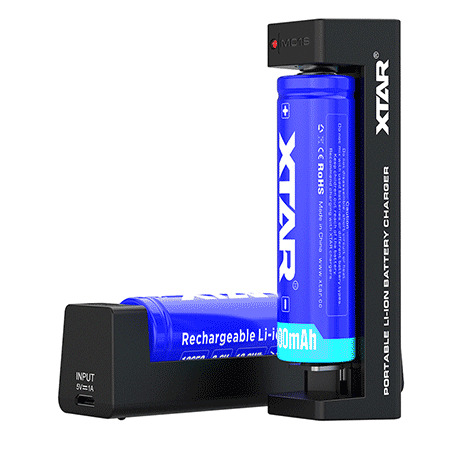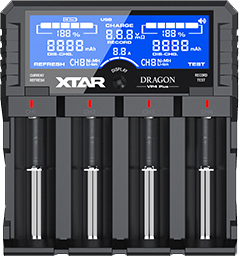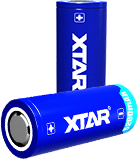
Xtar MC1S Li-ion charger
Specification
Professional processor charger for Li-ion cells in sizes 10440, 14500, 14650, 16340,
17500,17670, 18350, 18500, 18650, 18700, 20700, 21700, 22650, 25500, 26650
- three-stage charging method: TC /CC / CV
- reactivation of deeply discharged cells and 0V cells
- charging current: 1A
- charging voltage: 4.2V
- powered from micro USB - no power supply included
- security: thermal, short-circuit and reverse polarity protection
In a compact housing, there is a fully professional CPU charger with
three-stage charging process TC/CC/CC/CV. Charges 3.6 / 3.7V Li-ion cells with
any capacity in sizes 10440, 14500, 14650, 16340, 17500, 17670, 18350,
18500, 18650, 18700, 20700, 21700, 22650, 25500, 26650.
What is the TC/CC/CV charging method?
This is a three-stage process
charging Li-ion cells to ensure that the cells are kept in good condition by
charging with a suitable current at each stage and completing the charging process in the
The individual steps of the TC/CC/CV process are:
• TC Phase: cells discharged below 2.9V are 'woken up' by a lower current.
• Phase CC: when 2.9V is reached, the cell is charged with 1A direct current.
• CV Phase: when the cell is almost fully charged the charger switches to
charging with decreasing current until the voltage of 4.2V on the cell is reached. After
4.2V the charging process is completed - the battery is fully charged.
Batteries with a voltage of 4.1V or more are considered by the charger to be
fully charged. To fully charge such a battery, insert it into the charger before you power it up.
Charged batteries left in the charger will be subject to a natural process of self-discharge.
Charging will resume when the battery voltage drops below 4.1V.
The Xtar MC1S charger has the function of reactivating deeply discharged cells and
0V cells. Many chargers on the market are not able to charge such cells.
batteries. This is where the Xtar MC1S charger comes in.
Xtar MC1S is a charger that allows to "rescue" such kind of cells. You just need to insert deeply
discharged battery in MC1S charger, the charger will detect the discharged cell and attempt to reactivate it.
WARNING!
Cells discharged below a certain level are irreparably damaged and
their reactivation may be impossible. Avoid over-discharge of
Li-ion batteries - this can lead to a significant reduction in their lifespan and
their capacity or lead to their total failure.
Chargers from other manufacturers can significantly increase the temperature of the cells while charging.
Excessive heating of the cells may cause their faster degradation.
With the MC1S charger, Xtar has gone one step further than the competition,
solving this problem in a simple way: power is delivered from an external power supply.
Thanks to this, the temperature of the battery charged in MC1S will rise by at most by 15 degrees.
With Xtar MC1S charger we receive a micro USB cable and a cover.
to protect the charger during transport. The power supply is not included in tha package Any charger with a micro cable is sufficient to power the charger.
USB, e.g. from a phone, or a USB port, or a computer with a free USB port. Recommended
the minimum charger power is 1A (1000mA).
| Technical Data | |
| producer | Xtar |
| model | MC1S |
| compatible type of batteries | Li-ion batteries 3,6 - 3,7V, protected and unprotected |
| compatible size of batteries | 10440, 14500, 14650, 16340, 17500,17670, 18350, 18500, 18650, 18700, 20700, 21700, 22650, 25500, 26650 |
| maximum length of battery | 70mm |
| input voltage and current | 5V 1000mA |
| input type | micro USB |
| power supply inlcuded | NO |
| recommended power supply | minimum 5V 0,5A, recomended 5V 1A |
| chargind method | TC/CC/CV |
| current in the CC phase | 1000mA ±50mA |
| charging voltage cut-off | 4,2V ±0,05V |
| charging current cut-off | <40mA |
| additional functions | reactivation of deeply discharged cells and 0V cells |
| safety futures | thermal, short-circuit, reverse polarity protection |
| dimensions | 92 x 22 x 26mm |
| weight | 22g |
| package content | MC1S charger, micro USB cable, holster |
| warranty | 2 years |






